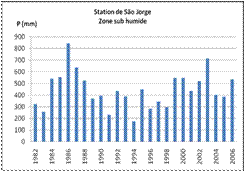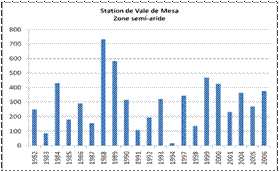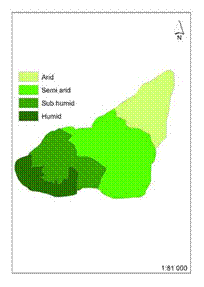Annual rainfall and seasonality
The climate of Ribeira Seca, as that of the entire country, is characterized by two seasons: an arid one that lasts 8-9 months from November to June and a short humid one, 2-4 months from July to October. The humid period coincides with high temperatures (Fig. 1).

Fig. 1: Average monthly and annually rainfall (mm) and temperature variation in the São Jorge station (sub-humid zone).
All the agricultural life of the basin and archipelago is connected to the amount of rain that falls during the rainfall period. The rain is generally extremely heterogeneous and its distribution in time and space is irregular (Fig.2).


Fig. 2: Evolution of the average annual precipitation (mm) evolution in the São Jorge and Vale de Mesa stations (1982-2006).
The climatic conditions regulate the development of the vegetation. According to Diniz and Matos (1987), the basin presents four bio-climatic areas. The following map and graphic give us the cartography and quantification of the zones, respectively (Fig. 3).

Fig. 3: Climatic zones of Ribeira Seca.
- A humid zone is located in the spring of the basin, where the Longueira, Ribeirão Galinha and Maton sub-basins are fitted. The annual rainfall can achieve or exceed 800mm. This region conglobates one of the main dense forest perimeters of the island, which has an approximate area of 7,73 km2.
- A sub-humid zone of approximately 14,38km2 (20,11%), where the precipitations vary between 400-700mm.
- A semi-arid zone (the most extensive of the basin) with a surface of 35,38 km2 (49,34%). In this area, the rainfall is inferior to 400mm. It is a typically agricultural zone, with some grazing land parcels and forestalls species of Prosopis juliflora, Azadirachta indica, Acacia holocericea.
- A sub-arid zone of around 14,11km2, with altitudes inferior to 200mm, very poor in woody vegetation with some species of: Prosopis juliflora, Ziziphus indica and others.
In the rainy periods, the water-bearing stratum, reservoirs and others are fully filled and the population and cultures are well-supplied. Nevertheless, in drought periods or with less rain, a crisis exists in all the sectors: agricultural production is deficient, and the population and animals suffer.